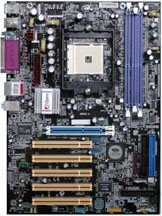Benchmarking
When benchmarking the Xpider II, we test the temperatures of key components including the actual CPU temperature, the actual temperature inside the heatsink, the temperatures of the DDR, Northbridge, Southbridge, HDD, PSU, and the ambient temperature inside the case, all during normal operation. For a system to operate efficiently, the components need to stay at a specified temperature to avoid system crashes, or worse, hardware damage. A well designed case should have an air flow system that is effective in keeping the hottest running components at a constant and stable temperature for optimal performance. During our testing, the PSU and CPU heatsink fans remain on to measure temperatures during normal system operations.AOpen AK86-L |
We took temperature readings of the components at 10 and 30 minutes of system operation time. When we first tested the Thermaltake Damier V6000A, we found the numbers to be much higher than we expected. We retested and found our results to be much closer to the actual expected numbers. Take a look at how the Chenbro Xpider II compares to the first case tested with our new test bed, the Thermaltake Damier V6000A.
| Chenbro Xpider II | |||||||||
| System On-Time | CPU | Heatsink | HDD | DDR | Northbridge | Southbridge | Power Supply | System Ambient | |
| 10 | 36 | 22.4 | 29.6 | 29.3 | 33.6 | 27.5 | 24.1 | 25.7 | |
| 30 | 45.2 | 29.5 | 31.1 | 30.4 | 34.2 | 28.6 | 26.8 | 26.4 | |
| Thermaltake Damier V6000A | |||||||||
| System On-Time | CPU | Heatsink | HDD | DDR | Northbridge | Southbridge | Power Supply | System Ambient | |
| 10 | 35.2 | 21.6 | 29.1 | 29.1 | 33.5 | 27.1 | 23.8 | 23.2 | |
| 30 | 43.6 | 28.4 | 30.2 | 30.1 | 33.9 | 28.4 | 26.4 | 25.8 | |
Since we retested the Damier, we could compare the temperatures of its benchmarks to those of the Xpider II. From the results, it is obvious that five 80mm fans are better than a 92mm paired with a single 120mm fan. CPU temperature readings were about 1 degree higher on the Xpider at 10 minutes of running time, and close to 2 degrees higher after 30 minutes. The other components followed with only a slight difference in temperature.
Though cooling is a major factor in choosing a good case, noise levels also affect the overall quality of the product. We tested the noise level of the Xpider II about 12" from the sealed case with the power supply and CPU fans turned off to reproduce the noise of the case alone. Since the test bed power supply and CPU heatsink fan were turned off, we were able to compare the Xpider II to the results of previous cases that we have tested.
| Case | dBA |
| Chenbro Xpider II | 45 |
| Thermaltake Damier V6000A | 53 |
| Super Flower X-Mask | 51 |
| Lian Li PC-V1000 | 46 |
| Opus Technologies MT-200 | 56 |
Though the V6000A had five fans, it was much quieter than the VM3000A, which had only four fans. Thermaltake decided to use variable speed fans as well as various models of fans, all having different output ratings with the V6000A instead of using all equally powerful fans throughout the chassis. This variance in output produced less noise, since only certain fans were required to operate at higher speeds than the others.











33 Comments
View All Comments
Operandi - Tuesday, August 10, 2004 - link
WTF?Stop reviewing these things.
Pixle - Tuesday, August 10, 2004 - link
What in the....What type of designers or artists did they have. That thing gives me a headache just looking at it.
Manzelle - Tuesday, August 10, 2004 - link
Fugly..